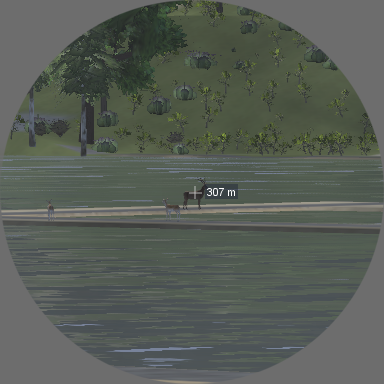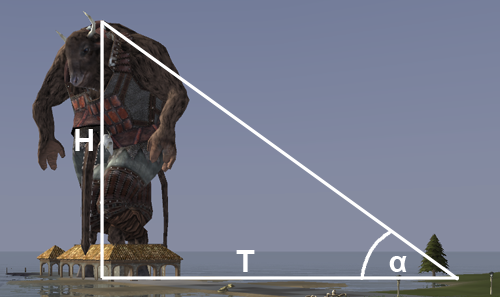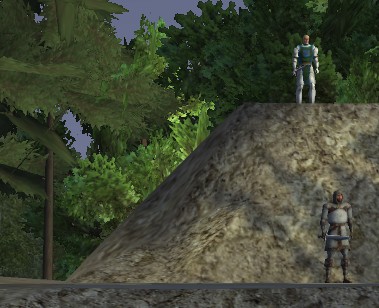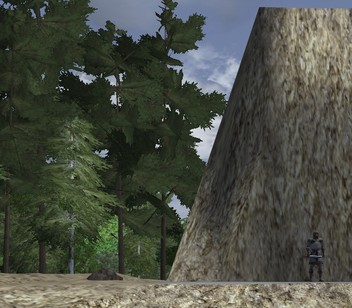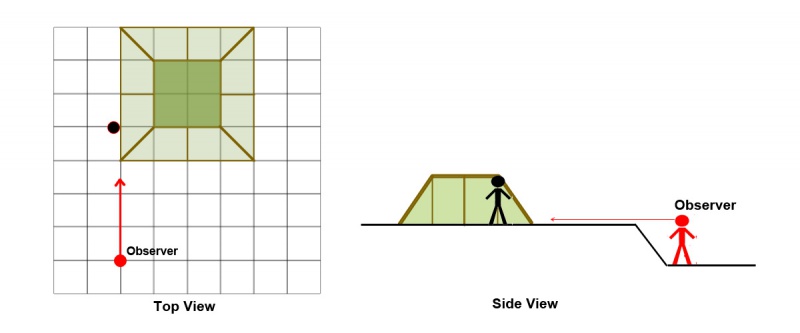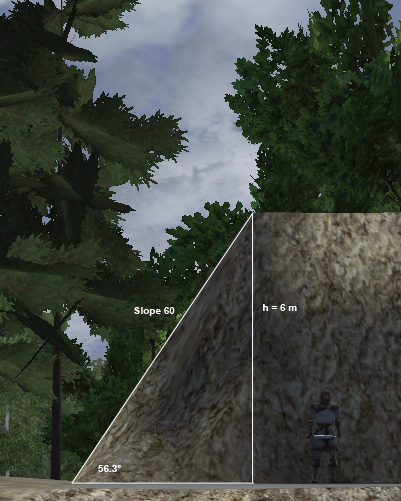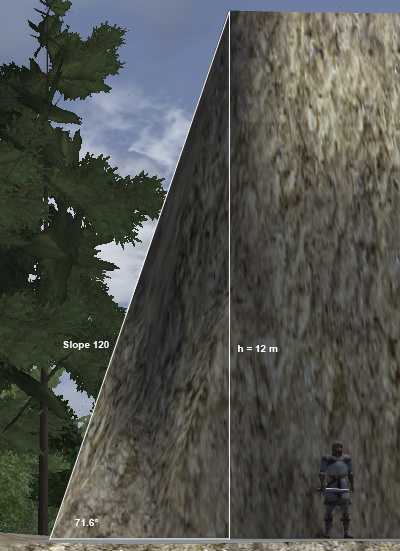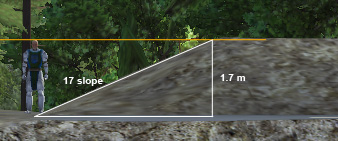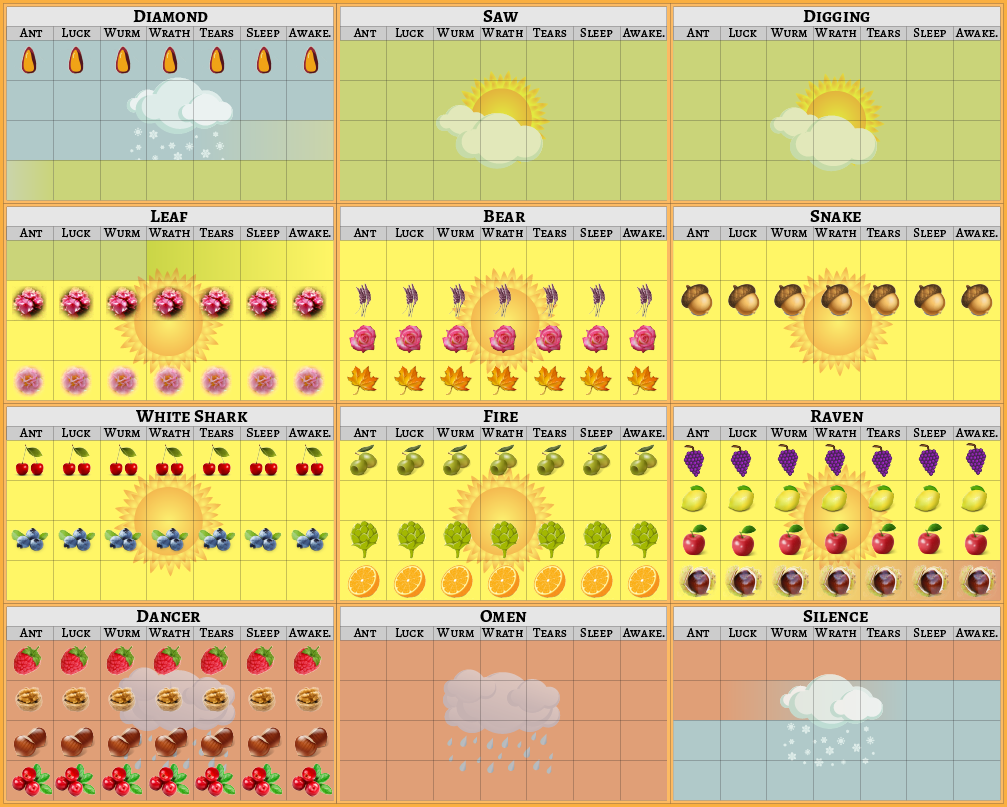Difference between revisions of "Wurm Universe"
Mordoskull (talk | contribs) m (Added another fact to "Quick References" section and did some work on the "Time, Seasons" section. More work coming) |
Mordoskull (talk | contribs) m (Added bullets for standard formatting.) |
||
| Line 3: | Line 3: | ||
== Quick References == | == Quick References == | ||
| − | 1 tile = 4 meter x 4 meter square. | + | * 1 tile = 4 meter x 4 meter square. |
| − | 250 tiles = 1 kilometer | + | * 250 tiles = 1 kilometer |
| − | 10 dirts (dropped or dug) = 1 meter of slope | + | * 10 dirts (dropped or dug) = 1 meter of slope |
| − | 1 real day = 8 Wurm days ~ALSO~ 1 Wurm day = 3 real-life hours ~ALSO~ 1 real-life hour = 8 Wurm hours ~ALSO~ 1 Wurm hour = 0.125 real-life hours (7.5 real minutes) | + | * 1 real day = 8 Wurm days ~ALSO~ 1 Wurm day = 3 real-life hours ~ALSO~ 1 real-life hour = 8 Wurm hours ~ALSO~ 1 Wurm hour = 0.125 real-life hours (7.5 real minutes) |
| − | 1 Wurm year = 336 Wurm days = 42 real days | + | * 1 Wurm year = 336 Wurm days = 42 real days |
== Distance, Slopes, and Height == | == Distance, Slopes, and Height == | ||
| − | The standard measurement designated to measuring distance in Wurm is the “tile”. Tiles are the equally sized squares that the landscape of Wurm Online is entirely composed of. In the 3D world of Wurm a tile can be either flat or inclined, so that one or more of its corners can be higher or lower than the others. | + | * The standard measurement designated to measuring distance in Wurm is the “tile”. Tiles are the equally sized squares that the landscape of Wurm Online is entirely composed of. In the 3D world of Wurm a tile can be either flat or inclined, so that one or more of its corners can be higher or lower than the others. |
| − | A relatively flat tile represents what in real-life would be a 4 meter by 4 meter square. Subsequently, 250 tiles then equals what would be, in real-life, 1 kilometer. | + | * A relatively flat tile represents what in real-life would be a 4 meter by 4 meter square. Subsequently, 250 tiles then equals what would be, in real-life, 1 kilometer. |
| − | Exact linear distance can easily be gleaned by using a [[spyglass]], as this tool will display the exact distance between the user and any distant object targeted within its viewing crosshairs. See picture for example: | + | * Exact linear distance can easily be gleaned by using a [[spyglass]], as this tool will display the exact distance between the user and any distant object targeted within its viewing crosshairs. See picture for example: |
[[File:Spyglass.png]] | [[File:Spyglass.png]] | ||
| Line 62: | Line 62: | ||
''*) Note: the ground floor of a house has a height of 3.3 m'' | ''*) Note: the ground floor of a house has a height of 3.3 m'' | ||
| − | Finally, talking about measuring heights, we must look at another basic unit of measurement used in the Wurm world: “dirts”. Whenever we see sloped tiles defining the 3D landscape, the elevation of slopes is given in terms of the amount of “dirts" dropped. When terraforming the land you use a shovel to dig or drop dirt - you add or subtract one “unit of dirt” with each action of the shovel. | + | * Finally, talking about measuring heights, we must look at another basic unit of measurement used in the Wurm world: “dirts”. Whenever we see sloped tiles defining the 3D landscape, the elevation of slopes is given in terms of the amount of “dirts" dropped. When terraforming the land you use a shovel to dig or drop dirt - you add or subtract one “unit of dirt” with each action of the shovel. |
| − | Using the method of triangulation described above, we can find out how these “units of dirt” correspond to metric units. By dropping dirt, we make elevated platforms of various heights thus creating different slopes. We then position an observer in a pit, so that the eye level is slightly above the ground, and take screenshots: | + | * Using the method of triangulation described above, we can find out how these “units of dirt” correspond to metric units. By dropping dirt, we make elevated platforms of various heights thus creating different slopes. We then position an observer in a pit, so that the eye level is slightly above the ground, and take screenshots: |
[[File:Slope04raw.jpg]] ..... [[File:Slope120raw.jpg]] | [[File:Slope04raw.jpg]] ..... [[File:Slope120raw.jpg]] | ||
| Line 156: | Line 156: | ||
== Time, Seasons == | == Time, Seasons == | ||
| − | The world of Wurm rotates rapidly around its axis: approximately 8 times faster than the real-life Earth. As a result, the following statements are true: | + | * The world of Wurm rotates rapidly around its axis: approximately 8 times faster than the real-life Earth. As a result, the following statements are true: |
'''1 real day = 8 Wurm days''' AND '''1 Wurm day = 3 real hours''' | '''1 real day = 8 Wurm days''' AND '''1 Wurm day = 3 real hours''' | ||
| Line 162: | Line 162: | ||
'''1 real hour = 8 Wurm hours''' AND '''1 Wurm hour = 0.125 real hours (7.5 real minutes)''' | '''1 real hour = 8 Wurm hours''' AND '''1 Wurm hour = 0.125 real hours (7.5 real minutes)''' | ||
| − | For more help with time, see the following '''Game Time Conversion Table''': | + | * For more help with time, see the following '''Game Time Conversion Table''': |
{| class="wikitable" | {| class="wikitable" | ||
| Line 339: | Line 339: | ||
| − | The Wurm world also experiences 4 different seasons called “winter”, “spring”, “summer”, and “autumn”. These seasons reoccur regularly after 336 Wurm days. As such: | + | * The Wurm world also experiences 4 different seasons called “winter”, “spring”, “summer”, and “autumn”. These seasons reoccur regularly after 336 Wurm days. As such: |
'''1 Wurm year = 336 Wurm days = 42 real days.''' | '''1 Wurm year = 336 Wurm days = 42 real days.''' | ||
| − | This is a convenient number, because 336 = 7 x 4 x 12, allowing us to split a Wurm year into 12 months (called “starfalls”), each with 4 weeks of 7 days. As such: | + | * This is a convenient number, because 336 = 7 x 4 x 12, allowing us to split a Wurm year into 12 months (called “starfalls”), each with 4 weeks of 7 days. As such: |
'''1 Wurm year = 12 starfalls | '''1 Wurm year = 12 starfalls | ||
| Line 349: | Line 349: | ||
1 Wurm week = 7 Wurm days = 21 real hours.''' | 1 Wurm week = 7 Wurm days = 21 real hours.''' | ||
| − | The 7 days in a Wurm week are called: | + | * The 7 days in a Wurm week are called: |
| − | *1. day: Day of the Ant | + | **1. day: Day of the Ant |
| − | *2. day: Day of Luck | + | **2. day: Day of Luck |
| − | *3. day: Day of the Wurm | + | **3. day: Day of the Wurm |
| − | *4. day: Day of Wrath | + | **4. day: Day of Wrath |
| − | *5. day: Day of Tears | + | **5. day: Day of Tears |
| − | *6. day: Day of Sleep | + | **6. day: Day of Sleep |
| − | *7. day: Day of Awakening | + | **7. day: Day of Awakening |
===The 12 Starfalls and Associated Harvest Seasons=== | ===The 12 Starfalls and Associated Harvest Seasons=== | ||
Revision as of 17:19, 28 November 2018
This page provides a rundown of the physics of the Wurm world. Below are sections individually designated to the various elements of these physics.
Contents
Quick References
- 1 tile = 4 meter x 4 meter square.
- 250 tiles = 1 kilometer
- 10 dirts (dropped or dug) = 1 meter of slope
- 1 real day = 8 Wurm days ~ALSO~ 1 Wurm day = 3 real-life hours ~ALSO~ 1 real-life hour = 8 Wurm hours ~ALSO~ 1 Wurm hour = 0.125 real-life hours (7.5 real minutes)
- 1 Wurm year = 336 Wurm days = 42 real days
Distance, Slopes, and Height
- The standard measurement designated to measuring distance in Wurm is the “tile”. Tiles are the equally sized squares that the landscape of Wurm Online is entirely composed of. In the 3D world of Wurm a tile can be either flat or inclined, so that one or more of its corners can be higher or lower than the others.
- A relatively flat tile represents what in real-life would be a 4 meter by 4 meter square. Subsequently, 250 tiles then equals what would be, in real-life, 1 kilometer.
- Exact linear distance can easily be gleaned by using a spyglass, as this tool will display the exact distance between the user and any distant object targeted within its viewing crosshairs. See picture for example:
However, when it comes to measuring heights and slopes, the spyglass is not quite accurate enough to always yield reliable results. Triangulation is thus recommended in such situations:
To use triangulation to determine the height (H) of an object, you must first define a reference point. To do so, take a screenshot (as shown in the example) and measure the angle (α) between the ground and the top of the object, as seen from the reference point. As we have no means to measure angles in-game, we need to use a graphics program to determine the angle on the screenshot. Additionally you need to measure the horizontal distance, which you obtain by counting the number of tiles T (remember: one tile corresponds to a distance of 4 meters). You then get the height H by using this formula:
H = T tan α
Here is an example: For a distance of 40 tiles (T=160m) we measure an angle of 14°. Thus, our avatar of Magranon would have a height of:
H = 160m ● tan(14°) = 40m
(Please note that the result has to be rounded, due to the immanent inaccuracy of this method.) Here is a list of heights for some arbitrary objects, just to give some examples:
| Object | Height (m) |
|---|---|
| Player character | 1.7 |
| House wall (1 floor) | 3.0 * |
| Pillar | 5.6 |
| Freedom tower (incl. flag) | 25 |
| Colossus | 34 |
| Deity avatar | 40 |
*) Note: the ground floor of a house has a height of 3.3 m
- Finally, talking about measuring heights, we must look at another basic unit of measurement used in the Wurm world: “dirts”. Whenever we see sloped tiles defining the 3D landscape, the elevation of slopes is given in terms of the amount of “dirts" dropped. When terraforming the land you use a shovel to dig or drop dirt - you add or subtract one “unit of dirt” with each action of the shovel.
- Using the method of triangulation described above, we can find out how these “units of dirt” correspond to metric units. By dropping dirt, we make elevated platforms of various heights thus creating different slopes. We then position an observer in a pit, so that the eye level is slightly above the ground, and take screenshots:
Measuring the angles and using the formula given above, we can triangulate the elevation of the platform:
We obtain the following table (for slopes spanning a single tile):
| Slope | Angle | Elevation (m) |
|---|---|---|
| 10 | 14.0 | 1.0 |
| 20 | 26.6 | 2.0 |
| 30 | 36.9 | 3.0 |
| 40 | 45.0 | 4.0 |
| 50 | 51.3 | 5.0 |
| 60 | 56.3 | 6.0 |
| 70 | 60.3 | 7.0 |
| 80 | 63.4 | 8.0 |
| 90 | 66.0 | 9.0 |
| 100 | 68.2 | 10.0 |
| 150 | 75.1 | 15.0 |
| 200 | 78.7 | 20.0 |
Thus, there is a simple relation between “dirts” and metric units:
1 meter = 10 dirts.
Using this method, it is also possible to determine the height of a player character with sufficient accuracy:
Volume
Volume is a measurement of how much space an item takes up. This measure is often not displayed in-game. Bulk bins are the one exception.
More Notes on Volume in Wurm:
- Liquids happen to be 1kg to 1L (weight to volume), and because of this, are often referenced in liters (L). Many sold items have different kg to L relationships. Examples:
- A small bucket can hold 12 L. A full bucket of water containers 12 L of water weighting 12 kg.
- A pottery bowl can hold 9 L and weights 0.50 kg. A filet of fish is 0.20 L and weights 0.30 kg. Thus, a pottery bowl can hold 45 filets (9 / 0.2 = 45) and will weight 14 kg (13.50 kg filet, 0.50 kg bowl).
- Volume puts limits on how much can fit in a container. All containers themselves consume slightly more volume then they hold. Hypothetically players can carry infinite volume and containers can hold infinite weight.
- You can calculate how many of an item will fit in a container by dividing the container's volume by the stored item's volume. See the Container page for a list of containers and volume capacities.
Time, Seasons
- The world of Wurm rotates rapidly around its axis: approximately 8 times faster than the real-life Earth. As a result, the following statements are true:
1 real day = 8 Wurm days AND 1 Wurm day = 3 real hours
1 real hour = 8 Wurm hours AND 1 Wurm hour = 0.125 real hours (7.5 real minutes)
- For more help with time, see the following Game Time Conversion Table:
| Real | Wurm | ||||||||||
|---|---|---|---|---|---|---|---|---|---|---|---|
| Minutes | Hours | Days | Weeks | Months | Years | Minutes | Hours | Days | Weeks | Months | Years |
| 1.00 | 0.02 | 0.00 | 0.00 | 0.00 | 0.00 | 8.00 | 0.13 | 0.01 | 0.00 | 0.00 | 0.00 |
| 60.00 | 1.00 | 0.04 | 0.01 | 0.00 | 0.00 | 480.00 | 8.00 | 0.33 | 0.05 | 0.01 | 0.00 |
| 1,440.00 | 24.00 | 1.00 | 0.14 | 0.03 | 0.00 | 11,520.00 | 192.00 | 8.00 | 1.14 | 0.25 | 0.02 |
| 10,080.00 | 168.00 | 7.00 | 1.00 | 0.23 | 0.02 | 80,640.00 | 1,344.00 | 56.00 | 8.00 | 1.92 | 0.16 |
| 43,829.10 | 730.49 | 30.44 | 4.35 | 1.00 | 0.08 | 350,632.80 | 5,843.88 | 243.50 | 34.79 | 8.76 | 0.73 |
| 525,949.00 | 8,765.82 | 365.24 | 52.18 | 12.00 | 1.00 | 4,207,592.00 | 70,126.53 | 2,921.94 | 417.42 | 104.40 | 8.70 |
| 0.13 | 0.00 | 0.00 | 0.00 | 0.00 | 0.00 | 1.00 | 0.02 | 0.00 | 0.00 | 0.00 | 0.00 |
| 7.50 | 0.13 | 0.01 | 0.00 | 0.00 | 0.00 | 60.00 | 1.00 | 0.04 | 0.01 | 0.00 | 0.00 |
| 180.00 | 3.00 | 0.13 | 0.02 | 0.00 | 0.00 | 1,440.00 | 24.00 | 1.00 | 0.14 | 0.04 | 0.00 |
| 1,260.00 | 21.00 | 0.88 | 0.13 | 0.03 | 0.00 | 10,080.00 | 168.00 | 7.00 | 1.00 | 0.25 | 0.02 |
| 5,040.00 | 84.00 | 3.50 | 0.50 | 0.11 | 0.01 | 40,320.00 | 672.00 | 28.00 | 4.00 | 1.00 | 0.08 |
| 60,480.00 | 1,008.00 | 42.00 | 6.00 | 1.37 | 0.11 | 483,840.00 | 8,064.00 | 336.00 | 48.00 | 12.00 | 1.00 |
- The Wurm world also experiences 4 different seasons called “winter”, “spring”, “summer”, and “autumn”. These seasons reoccur regularly after 336 Wurm days. As such:
1 Wurm year = 336 Wurm days = 42 real days.
- This is a convenient number, because 336 = 7 x 4 x 12, allowing us to split a Wurm year into 12 months (called “starfalls”), each with 4 weeks of 7 days. As such:
1 Wurm year = 12 starfalls
1 starfall = 4 Wurm weeks = 3.5 real days
1 Wurm week = 7 Wurm days = 21 real hours.
- The 7 days in a Wurm week are called:
- 1. day: Day of the Ant
- 2. day: Day of Luck
- 3. day: Day of the Wurm
- 4. day: Day of Wrath
- 5. day: Day of Tears
- 6. day: Day of Sleep
- 7. day: Day of Awakening
The 12 Starfalls and Associated Harvest Seasons
- Diamond Starfall - Pinenut (week 1)
- Saw Starfall - No seasons
- Digging Starfall - No seasons
- Leaf Starfall - Oleander (week 2), Camellia (week 4),
- Bear starfall - Lavender (week 2), Rose (week 3), Maple (week 4)
- Snake starfall - Acorn (week 2)
- White Shark starfall - Cherry (week 1)
- Fire Starfall - Olive (week 1), Blueberry (week 2), Hops (week 3), Orange (week 4)
- Raven starfall - Grape (week 1), Lemon (week 2), Apple (week 3), Chestnut season (week 4)
- Dancer Starfall - Raspberry season (week 1), Walnut (week 2), Hazelnut (week 3), Lingonberry season (week 4)
- Omen Starfall - No seasons
- Silent Starfall - No seasons
Weekdays (7)
- Day of the Ant
- Day of the Luck
- Day of the Wurm
- Day of the Wrath
- Day of the Tear
- Day of the Sleep
- Day of the Awakening
Seasons
The Wurm year has 4 seasons:
- Spring (beginning in week 3 of the Diamond Starfall)
- Summer (beginning in week 1 of the Leaf Starfall)
- Autumn (beginning in week 4 of the Raven Starfall)
- Winter (beginning in week 2 of the Silent Starfall).
This is the Wurm calendar, showing days, weeks, starfalls, and the seasons:
- Please note: The actual season for harvest can be -/+ 2 weeks. Also any day (and any min in that day) in that week.
(Image taken from Yaga's "WurmClock V3", by courtesy of Yaga.)
